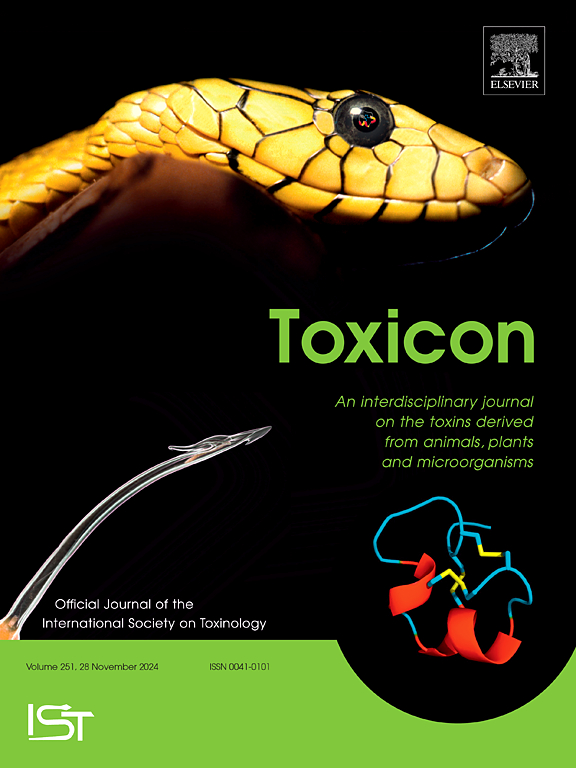A preliminary investigation into the activity and toxicity of an amyloid-based Emodin formulation
IF 2.6
4区 医学
Q2 PHARMACOLOGY & PHARMACY
引用次数: 0
Abstract
Emodin is a natural plant derivative with many therapeutic properties including anti-cancer, anti-apoptosis, and anti-inflammatory effects. However, the delivery of Emodin is quite challenging due to its superhydrophobic properties. Furthermore, conventional systemic delivery approaches often result in side effects. Thus, alternative strategies are important for the successful delivery of Emodin. The goal of this study was to develop a novel Emodin drug depot utilizing peptide amyloids. For the peptides, an aggregation-prone amino acid domain of receptor-interacting serine/threonine-protein kinase 3 (RIP3) protein was used. The RIP3/Emodin amyloid aggregates physicochemical characterization, cellular uptake, effects on toxicity, oxidative stress, and inflammation were investigated. Studies reveal that Emodin-encapsulated RIP3 peptide amyloid aggregates were able to induce significant lung cancer cell toxicity compared to free Emodin. Further, aggregates alone did not exhibit toxicity and or oxidative stress. In addition, the formulation was able to inhibit lipopolysaccharide (LPS) mediated inflammation in macrophage cells. Overall, the studies indicate the potential of RIP3 peptide amyloids as hydrophobic drug depots.

淀粉样蛋白大黄素制剂的活性和毒性的初步研究
大黄素是一种天然植物衍生物,具有抗癌、抗细胞凋亡和抗炎等多种治疗作用。然而,由于大黄素的超疏水性,其递送相当具有挑战性。此外,传统的系统给药方法往往会导致副作用。因此,替代策略对于大黄素的成功递送很重要。本研究的目的是利用肽淀粉样蛋白开发一种新的大黄素药库。对于肽,使用了受体相互作用丝氨酸/苏氨酸蛋白激酶3 (RIP3)蛋白的一个易于聚集的氨基酸结构域。研究了RIP3/大黄素淀粉样蛋白聚集体的理化特性、细胞摄取、毒性、氧化应激和炎症的影响。研究表明,与游离大黄素相比,大黄素包裹的RIP3肽淀粉样蛋白聚集体能够诱导显著的肺癌细胞毒性。此外,聚集体单独不表现出毒性和/或氧化应激。此外,该制剂能够抑制巨噬细胞中脂多糖(LPS)介导的炎症。总的来说,这些研究表明RIP3肽淀粉样蛋白作为疏水性药物仓库的潜力。
本文章由计算机程序翻译,如有差异,请以英文原文为准。
求助全文
约1分钟内获得全文
求助全文
来源期刊

Toxicon
医学-毒理学
CiteScore
4.80
自引率
10.70%
发文量
358
审稿时长
68 days
期刊介绍:
Toxicon has an open access mirror Toxicon: X, sharing the same aims and scope, editorial team, submission system and rigorous peer review. An introductory offer Toxicon: X - full waiver of the Open Access fee.
Toxicon''s "aims and scope" are to publish:
-articles containing the results of original research on problems related to toxins derived from animals, plants and microorganisms
-papers on novel findings related to the chemical, pharmacological, toxicological, and immunological properties of natural toxins
-molecular biological studies of toxins and other genes from poisonous and venomous organisms that advance understanding of the role or function of toxins
-clinical observations on poisoning and envenoming where a new therapeutic principle has been proposed or a decidedly superior clinical result has been obtained.
-material on the use of toxins as tools in studying biological processes and material on subjects related to venom and antivenom problems.
-articles on the translational application of toxins, for example as drugs and insecticides
-epidemiological studies on envenoming or poisoning, so long as they highlight a previously unrecognised medical problem or provide insight into the prevention or medical treatment of envenoming or poisoning. Retrospective surveys of hospital records, especially those lacking species identification, will not be considered for publication. Properly designed prospective community-based surveys are strongly encouraged.
-articles describing well-known activities of venoms, such as antibacterial, anticancer, and analgesic activities of arachnid venoms, without any attempt to define the mechanism of action or purify the active component, will not be considered for publication in Toxicon.
-review articles on problems related to toxinology.
To encourage the exchange of ideas, sections of the journal may be devoted to Short Communications, Letters to the Editor and activities of the affiliated societies.
 求助内容:
求助内容: 应助结果提醒方式:
应助结果提醒方式:


